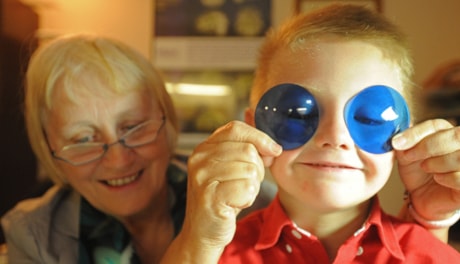At the end of kindergarten in June, when teachers approached Andy Nelson about her son not picking up his alphabet, she knew something needed to be done.
When five-year-old Kade Nelson looked at the words on the page they “wiggled” and he had a hard time with the fluorescent lights at school. He’d rub his eyes and they would get red.
Andy took him to the Learning Disabilities Association Red Deer Chapter, underneath Sproule’s Mountview IDA Drugstore in Red Deer.
Julie Stirling, the program director of the Learning Disabilities Association, asked Kade and Andy a number of questions and determined the little boy had Irlen syndrome.
Irlen syndrome was first discovered by educational psychologist Helen Irlen in the 1980s, when she was looking into why some university students were inefficient readers. She began to ask them what reading was like for them and what made them want to stop reading.
“Many of the students talked about the brightness of the page. For others the white came up stronger than the black print.
So their eyes were attracted to the white and the bright,” said Adel Francis, an Irlen syndrome specialist, in Red Deer during the weekend. “For some, they had difficulty with the print.
The print moved, it jiggled, it waved.
So there were a lot of distractions on the page that would get in the way of someone being an efficient reader.”
Others have trouble with the span of recognition, only being able to take in a portion of the word at a time. For other people suffering from the syndrome their depth perception is affected, allowing them to be able to throw a ball, but not catch it.
Irlen experimented with laying different clear colours over the sheet of paper students read and for some the words stopped jiggling and the print was easier to read. A range of colours were tried and eventually different coloured lens were used to filter the light and help the brain process the information more easily.
At the Learning Disabilities Association office, Kade was able to learn with the lights being turned down in the room and clear overlays of colours set on the bright white page to filter the reflection of the light on it.
Within three weeks he was picking up his alphabet.
Andy saw the difference in her son when he started reading things off the television screen. Now at the end of the summer he is working on three and four-letter words. Kade went through more screening this past weekend to find the right colour of lens that will help him.
“It is a piece of the puzzle,” Francis said. “We don’t rescue every situation. Sometimes there is a dramatic change. For others there are other issues too.”
A two-hour screening test can be done at the Learning Disabilities Association office by Stirling, who is an Irlen certified screener. If it looks like the child or adult is suffering from the syndrome, another appointment to determine what colour of lens could make a difference is done by Francis. She is based in Ottawa, Ont., but makes regular trips to Red Deer to do the testing. The cost for the screening, testing and lens is around $1,000.
Andy said it is worth it if it makes a difference for her son. She said she is hoping they’ve caught it fast enough that he can catch on and be comfortable reading.
“Now he is getting blue glasses and he is really excited,” Andy said.
sobrien@www.reddeeradvocate.com
